What Are Pierogies?
Pierogies are traditional Eastern European dumplings that consist of tender dough wrapped around a variety of fillings. These half-moon shaped pockets originated in Poland where they’re known as “pierogi” (pierogi is actually the plural form while pieróg is singular). Throughout Eastern Europe you’ll find similar versions with different names such as varenyky in Ukraine or pelmeni in Russia.
The dough for pierogies typically combines flour water eggs and sometimes sour cream to create a soft yet sturdy wrapper. This dough encases fillings that range from savory to sweet depending on regional traditions and family preferences. Most popular savory fillings include potato and cheese (ruskie) sauerkraut with mushrooms ground meat or cabbage. Sweet variations often feature seasonal fruits like blueberries cherries or plums mixed with sugar.
What makes pierogies special is their versatility in preparation. You can boil them for a soft texture pan-fry them for a crispy exterior or even bake them. Traditional serving methods include topping them with caramelized onions crispy bacon bits or a dollop of sour cream. In Poland pierogies remain a staple dish for holidays like Christmas Eve when meatless versions are served as part of the traditional Wigilia feast.
Today pierogies have gained international popularity beyond Eastern European communities. Many grocery stores sell frozen varieties but these mass-produced versions rarely capture the delicate texture and rich flavors of homemade pierogies. Making them from scratch allows you to experience the authentic taste and texture that has made this humble dumpling beloved across generations.
Why You’ll Love This Homemade Pierogi Recipe

These homemade pierogies will quickly become a family favorite for several compelling reasons. The recipe uses simple pantry ingredients that transform into pillowy pockets of comfort food magic right in your kitchen. Fresh pierogies offer a texture and flavor that store-bought versions simply cannot match with their tender dough and customizable fillings.
Making pierogies from scratch connects you to centuries of culinary tradition while allowing for modern interpretations that suit your taste preferences. The dough comes together easily without specialized equipment making this an accessible project even for novice cooks. Your kitchen will fill with irresistible aromas as you prepare both the dough and filling components.
These dumplings freeze beautifully allowing you to make a large batch once and enjoy homemade pierogies for months to come. Each bite delivers the perfect balance of tender dough and flavorful filling creating an eating experience that’s both satisfying and nostalgic. The versatility of serving options means pierogies work equally well as appetizers side dishes or main courses.
The recipe includes clear step-by-step instructions that remove the intimidation factor from making this traditional dish. Your friends and family will be impressed by your culinary skills when you present these handcrafted pierogies at your next gathering.
Equipment Needed
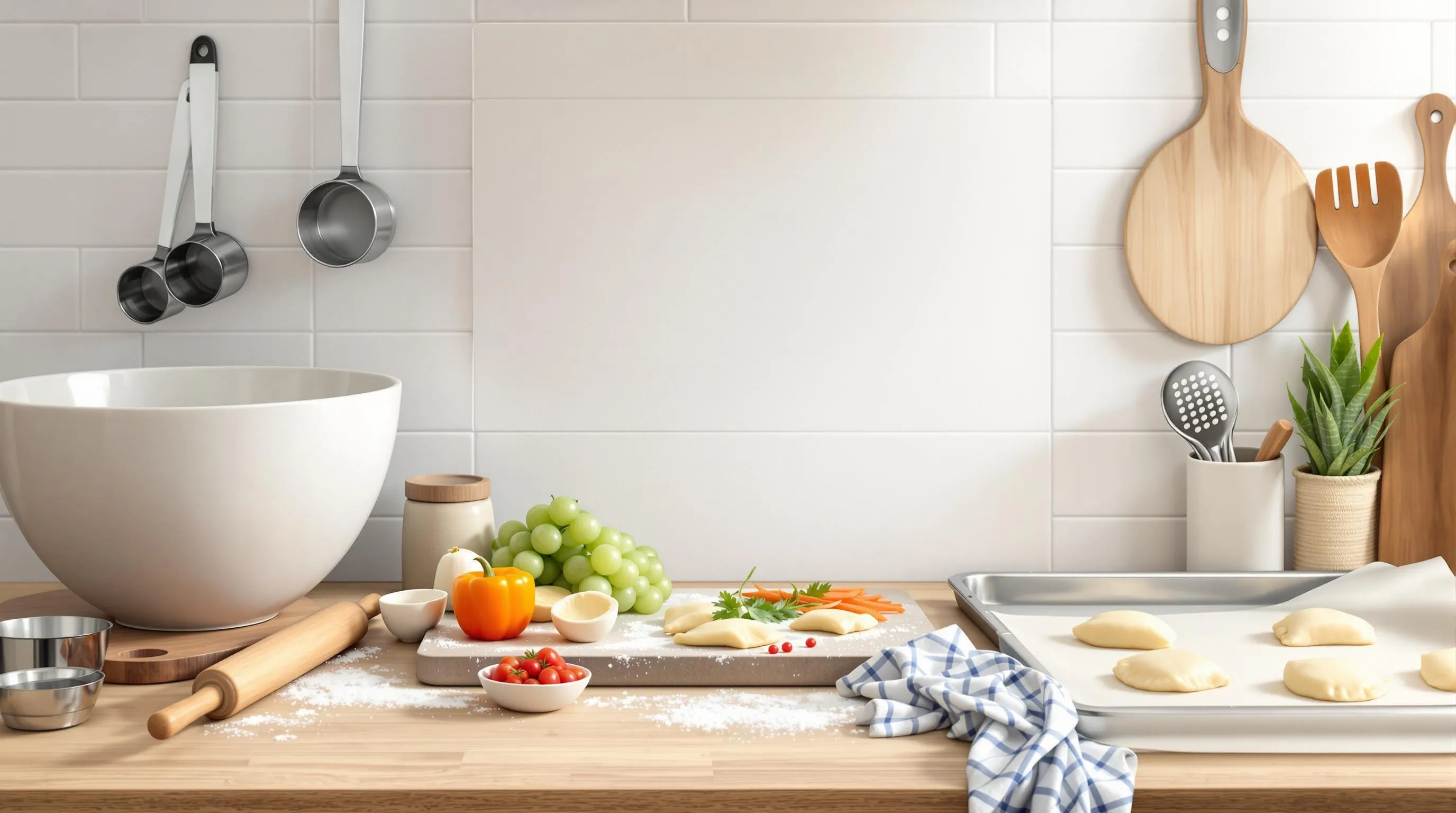
Creating homemade pierogies requires just a few basic kitchen tools you likely already have on hand. Gather these items before starting your pierogi-making adventure:
- Large mixing bowl for preparing and kneading the dough
- Measuring cups and spoons for accurate ingredient portions
- Rolling pin to achieve the perfect dough thickness
- Round cookie cutter or drinking glass (3-4 inches in diameter) for cutting pierogi circles
- Slotted spoon for removing boiled pierogies from water
- Large pot for boiling the finished pierogies
- Skillet or frying pan if you plan to pan-fry after boiling
- Pastry brush for applying egg wash to seal edges
- Fork or pierogi press to crimp the edges
- Clean kitchen towel to cover resting dough
- Baking sheet lined with parchment paper for placing formed pierogies
- Potato masher if making potato filling
- Cutting board and knife for preparing filling ingredients
- Strainer for draining boiled potatoes or sauerkraut
Your workspace should include a clean counter or table with enough room to roll out dough and form multiple pierogies at once. Setting up all equipment before starting makes the process flow smoothly and ensures nothing is forgotten during the critical assembly phase.
Ingredients For Homemade Pierogies
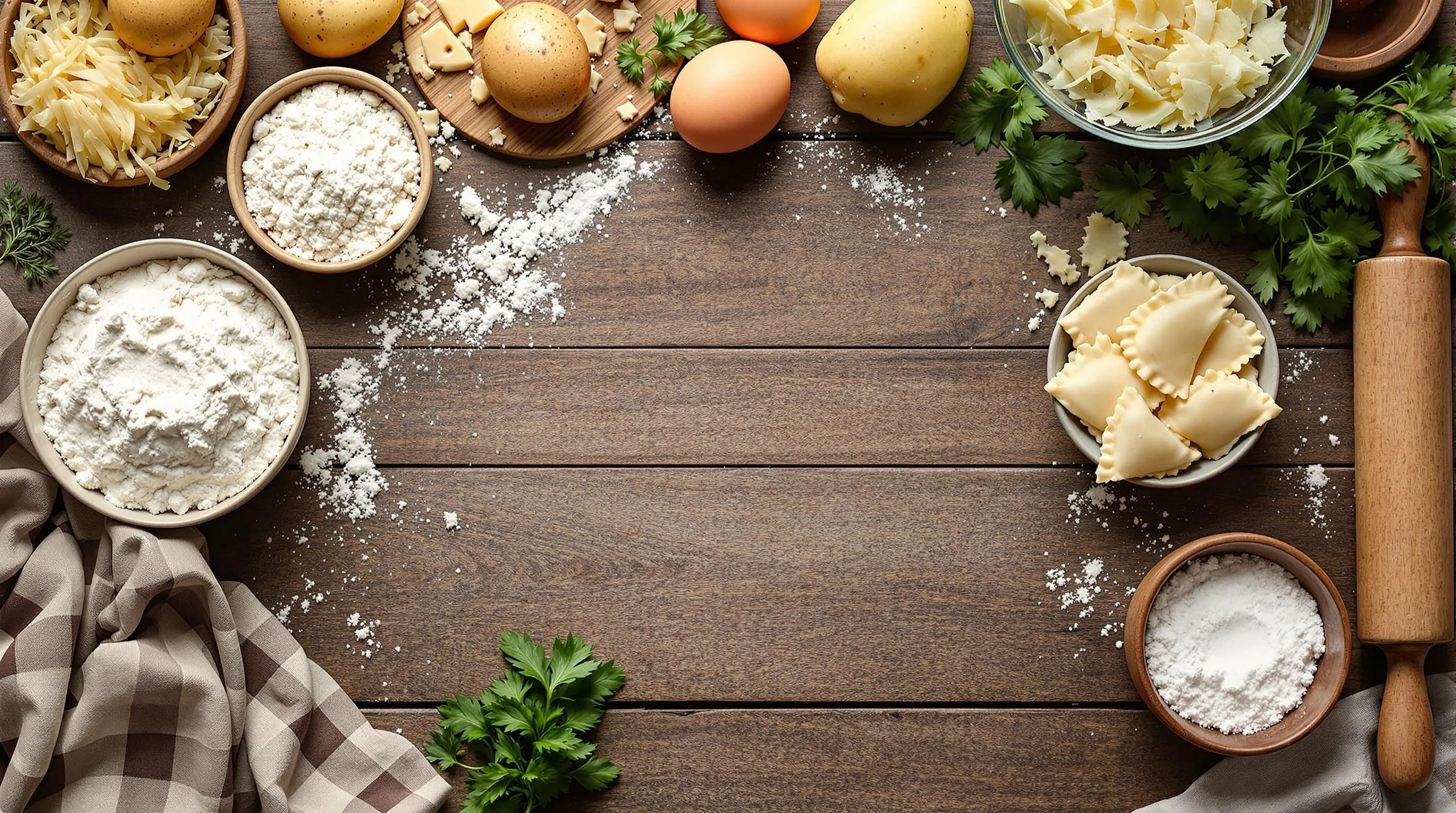
Success with pierogies begins with quality ingredients. Below you’ll find everything needed to create these delicious Polish dumplings from scratch including options for traditional fillings.
For The Dough
- 4 cups all-purpose flour
- 1 teaspoon salt
- 1 large egg
- 2 tablespoons sour cream
- 3/4 to 1 cup warm water
- 1 tablespoon vegetable oil
For The Potato And Cheese Filling
- 2 pounds russet potatoes peeled and quartered
- 2 tablespoons butter
- 1 medium onion finely diced
- 1 1/2 cups farmer’s cheese or dry curd cottage cheese
- Salt and pepper to taste
- 1/4 teaspoon garlic powder (optional)
- 2 tablespoons chopped fresh chives (optional)
For The Sauerkraut Filling (Optional)
- 2 cups sauerkraut drained and rinsed
- 1 tablespoon vegetable oil
- 1 medium onion finely chopped
- 8 ounces mushrooms finely chopped (cremini or button work well)
- 2 tablespoons butter
- Salt and pepper to taste
- 1/4 teaspoon caraway seeds (optional)
- 1 tablespoon fresh dill chopped (optional)
How To Make Pierogi Dough
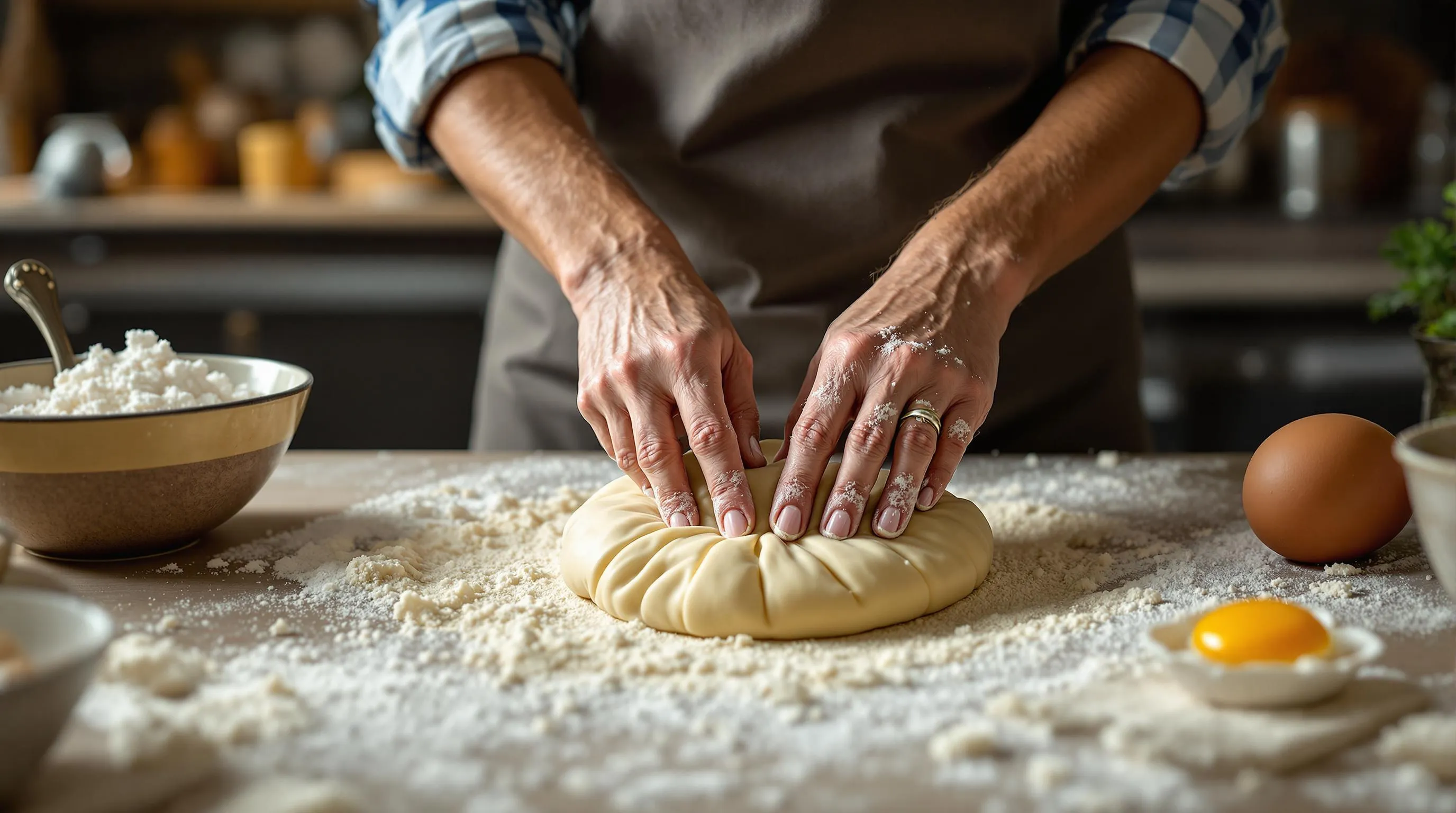
Creating the perfect pierogi dough is the foundation of delicious homemade pierogies. The ideal dough should be soft yet sturdy enough to hold your filling without breaking during the cooking process. Follow these steps to achieve a tender elastic dough that will make your babcia proud:
- Whisk together 3 cups of all-purpose flour and 1 teaspoon of salt in a large mixing bowl to ensure even distribution.
- Make a well in the center of your flour mixture and add 1 beaten egg 1/2 cup of sour cream and 1/4 cup of warm water.
- Drizzle 2 tablespoons of vegetable oil into the well with the wet ingredients.
- Mix everything together using a wooden spoon until the ingredients start to come together forming a shaggy dough.
- Turn the dough onto a lightly floured surface and knead for about 5-7 minutes until smooth and elastic. The dough should feel soft but not sticky.
- Test the dough by pressing your finger into it – the indentation should slowly spring back indicating perfect elasticity.
- Form the dough into a ball and place it back in the bowl. Cover with a clean kitchen towel or plastic wrap.
- Allow the dough to rest for at least 30 minutes at room temperature. This resting period relaxes the gluten making the dough easier to roll out.
The success of your pierogi dough depends largely on proper kneading and resting time. Working the dough develops the gluten network providing structure while the rest period ensures the dough will be pliable when rolled. You’ll know your dough is ready when it feels smooth supple and slightly tacky but not sticky to the touch.
For best results use room temperature ingredients especially the sour cream and egg as cold ingredients can make the dough tougher to work with. If the dough feels too dry during kneading add warm water one tablespoon at a time. Conversely if it feels too sticky sprinkle in additional flour gradually.
Many Polish families pass down their own special techniques for pierogi dough. Some swear by adding a splash of vodka to the mixture which evaporates during cooking resulting in an exceptionally tender texture. Others insist on using only mineral water instead of tap water. Feel free to incorporate these traditional variations once you’ve mastered the basic recipe.
How To Make The Fillings
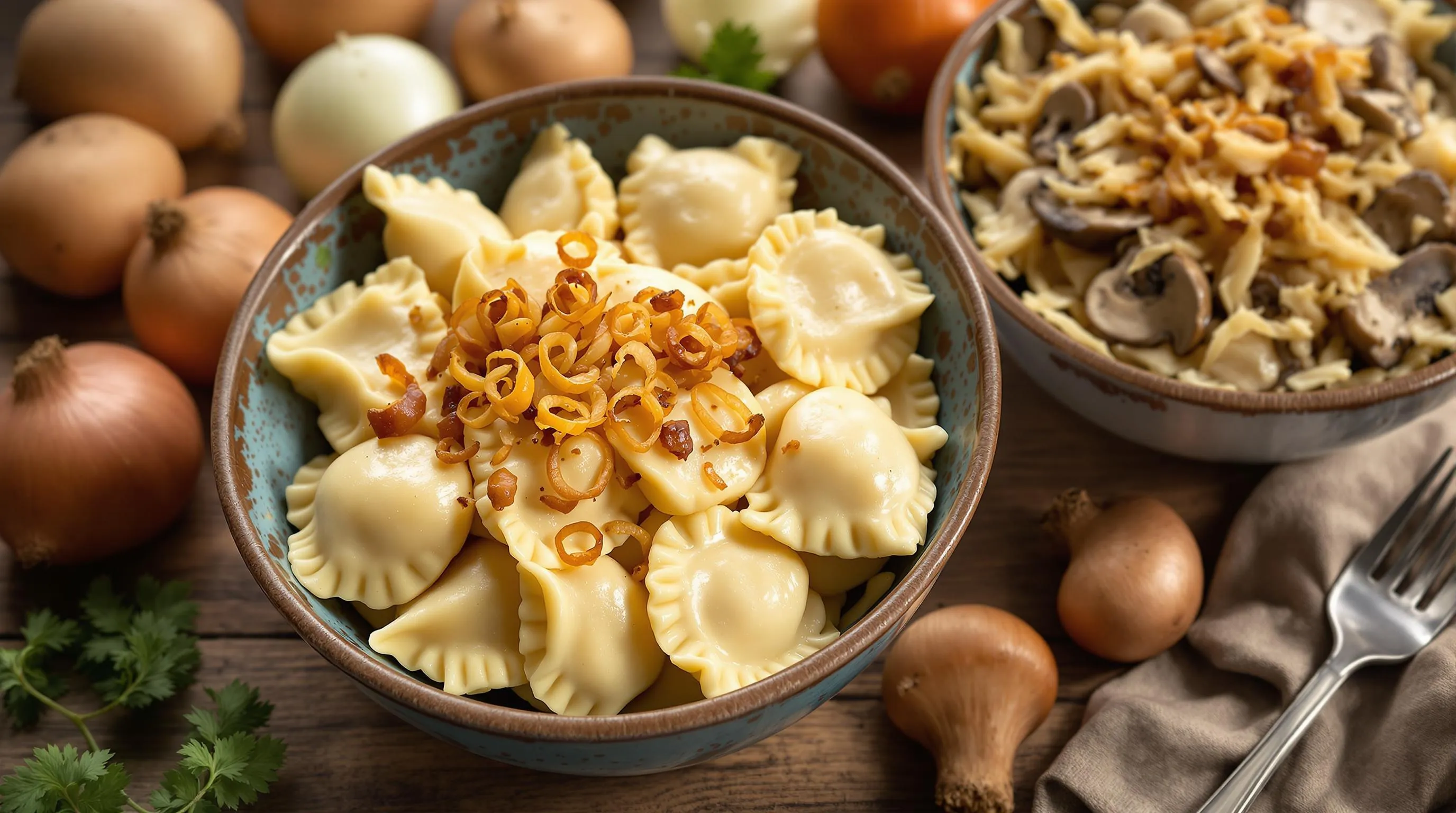
Creating delicious pierogi fillings is just as important as perfecting the dough. These two classic filling recipes will give you authentic flavors that pair perfectly with your homemade pierogi wrappers.
Potato And Cheese Filling
- Place 2 pounds of peeled and quartered russet potatoes in a large pot and cover with cold water.
- Add 1 teaspoon of salt to the water and bring to a boil over high heat.
- Reduce heat to medium and simmer until potatoes are fork-tender, about 15-20 minutes.
- While potatoes cook, melt 2 tablespoons of butter in a skillet over medium heat.
- Add 1 finely diced medium onion and sauté until translucent and golden, about 5-7 minutes.
- Drain the potatoes thoroughly and return them to the pot.
- Mash the potatoes until smooth using a potato masher or ricer.
- Fold in the sautéed onions and 1½ cups of farmer’s cheese or dry curd cottage cheese.
- Season with salt and pepper to taste, adding ¼ teaspoon of garlic powder if desired.
- Allow the mixture to cool completely before filling your pierogies.
For the best texture, avoid overmixing the potatoes which can make them gluey. The filling should be firm enough to hold its shape but soft enough to mold easily. You can prepare this filling a day ahead and refrigerate it in an airtight container.
Sauerkraut Filling
- Drain 2 cups of sauerkraut in a colander, pressing out excess liquid.
- Rinse the sauerkraut briefly under cold water if you prefer a milder flavor.
- Chop the sauerkraut into smaller pieces for easier filling.
- Heat 2 tablespoons of butter in a large skillet over medium heat.
- Add 1 finely diced medium onion and cook until softened, about 4 minutes.
- Add 8 ounces of finely chopped mushrooms (cremini or white button) to the skillet.
- Cook the mushrooms and onions until mushrooms release their moisture and begin to brown, about 6-8 minutes.
- Stir in the drained sauerkraut and continue cooking for 5 minutes.
- Season with ¼ teaspoon caraway seeds, ⅛ teaspoon black pepper, and salt to taste.
- Allow the mixture to cool completely before using as filling.
This tangy filling benefits from being made at least a few hours ahead, giving the flavors time to meld together. Make sure to squeeze out any excess moisture before filling your pierogies to prevent soggy dumplings. The filling keeps well in the refrigerator for up to 3 days, making it perfect for meal prep.
How To Assemble Pierogies

Assembling pierogies is where your preparation efforts truly come together. Follow these steps to create perfectly shaped dumplings that will hold their filling securely during cooking.
Begin by dividing your rested dough into manageable portions. Roll each portion on a lightly floured surface to about 1/8-inch thickness – thin enough to be tender when cooked but sturdy enough to contain the filling.
Using a 3-inch round cutter or a drinking glass, cut circles from the rolled dough. Gather any scraps to re-roll and cut additional circles until all dough is used.
Place about 1 tablespoon of your prepared filling in the center of each dough circle. Adjust the amount based on the size of your circles – you want enough filling for flavor but not so much that it prevents proper sealing.
Fold the dough over the filling to create a half-moon shape. Press the edges firmly with your fingers to seal, ensuring no filling can escape during cooking. For extra security, press the tines of a fork around the edges to create a decorative crimped seal.
Transfer your assembled pierogies to a lightly floured baking sheet, making sure they don’t touch each other to prevent sticking. Cover them with a clean kitchen towel to prevent drying out if you’re not cooking them immediately.
Work in batches if needed, keeping the unused dough covered to maintain moisture. Your filled pierogies can be cooked right away or frozen for later enjoyment.
Remember that practice makes perfect when it comes to assembly. Your first few pierogies might look rustic, but you’ll quickly develop a rhythm that results in more uniform dumplings.
Cooking Your Homemade Pierogies
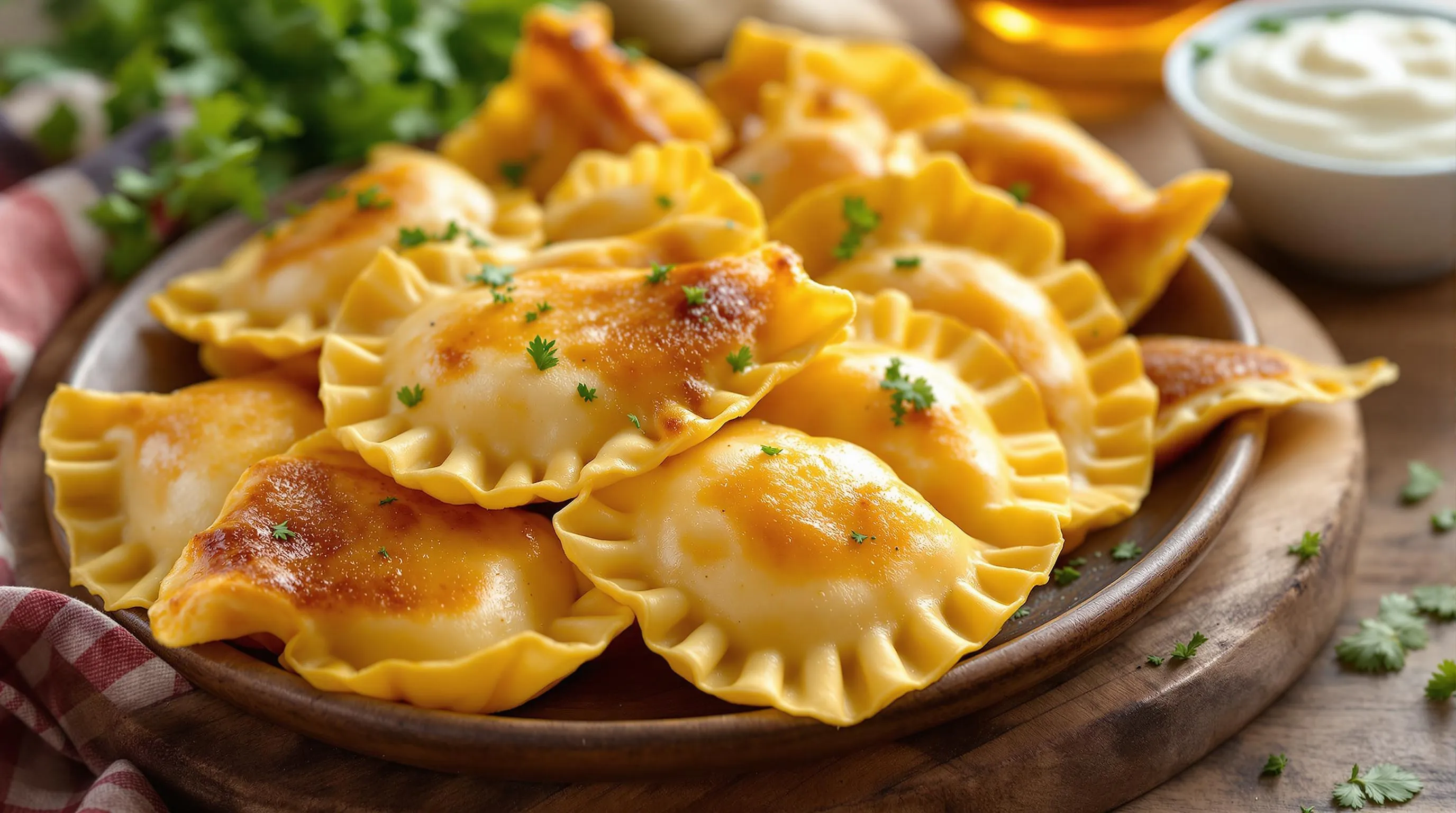
Now that you’ve assembled your pierogies, it’s time to cook these delicious Polish dumplings to perfection. The two most popular methods—boiling and pan-frying—each offer distinct textures and flavors that highlight your homemade creations.
Boiling Method
Boiling is the traditional first step for cooking pierogies, resulting in tender dumplings with a silky texture. Fill a large pot with water (about ¾ full) and add 1 tablespoon of salt to enhance flavor. Bring the water to a rolling boil over high heat before carefully dropping in your pierogies. Work in batches of 6-8 dumplings to prevent overcrowding and sticking. The pierogies will initially sink to the bottom of the pot but will float to the surface when they’re nearly done—this typically takes 2-3 minutes for fresh pierogies or 5-7 minutes for frozen ones.
Using a slotted spoon, gently remove the floating pierogies from the water and transfer them to a colander to drain briefly. You can serve them immediately with traditional toppings like melted butter, caramelized onions, and sour cream for an authentic Polish experience. Boiled pierogies have a soft, pillowy texture that beautifully complements both savory and sweet fillings.
Pan-Frying Method
Pan-frying transforms your pierogies into golden, crispy delights with irresistible texture contrast. Heat 2 tablespoons of butter or a combination of butter and vegetable oil in a large skillet over medium heat. Place your boiled pierogies in the hot pan, arranging them in a single layer with space between each dumpling. Allow them to cook undisturbed for 2-3 minutes until the bottoms develop a golden-brown crust.
Flip each pierogi carefully using a spatula and cook the other side for an additional 2 minutes until crispy. The contrast between the crisp exterior and tender filling creates an exceptional eating experience. For extra flavor, add sliced onions to the pan before the pierogies, allowing them to caramelize alongside your dumplings. Sprinkle with chopped fresh herbs like dill or parsley before serving for a pop of color and freshness.
Pan-fried pierogies pair wonderfully with a dollop of sour cream, applesauce for sweet varieties, or a simple green salad for a complete meal. This method works best with pierogies that have been boiled first, though you can pan-fry them directly from frozen by extending the cooking time and using a lower heat to ensure they cook through completely.
Serving Suggestions
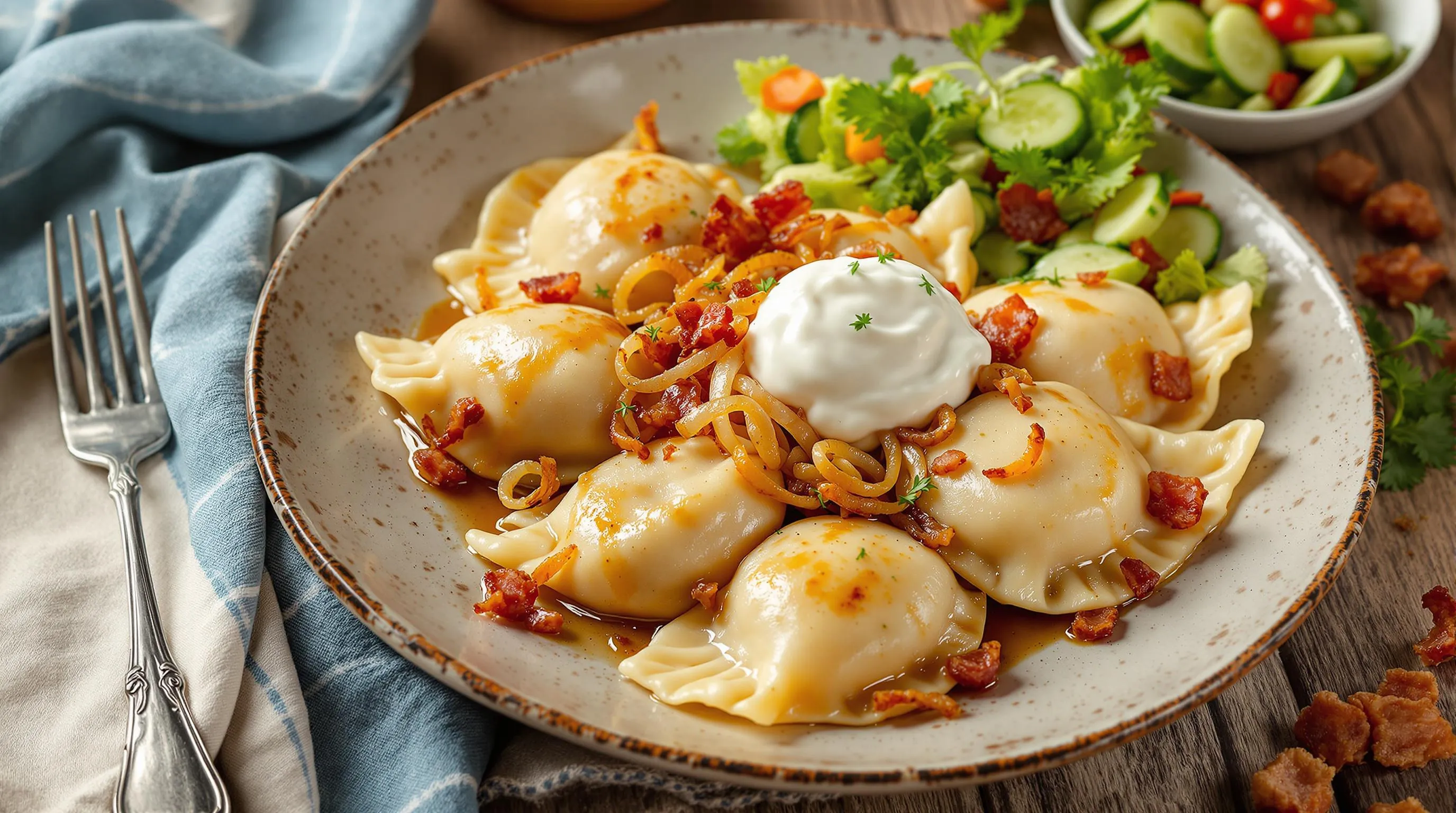
Pierogies shine brightest when paired with complementary accompaniments that enhance their flavors and textures. Traditional Polish service includes a generous topping of caramelized onions and a dollop of sour cream which adds richness and tanginess to balance the dumplings. Crispy bacon bits sprinkled over freshly cooked pierogies provide a smoky contrast to the soft dough and hearty filling.
For a complete meal experience try serving your homemade pierogies alongside braised red cabbage or a crisp cucumber salad dressed with dill and vinegar. These side dishes cut through the richness of the dumplings with their bright acidity. Mushroom gravy makes an excellent sauce option particularly for potato-filled varieties creating a comforting umami-rich combination.
Sweet pierogi variations benefit from different accompaniments. Fruit-filled pierogies taste delicious with a light dusting of powdered sugar or a drizzle of honey. Warm berry compote spooned over sweet cheese pierogies creates an elegant dessert presentation while a scoop of vanilla ice cream transforms them into an indulgent treat.
Consider the occasion when planning your pierogi presentation. Family-style service works wonderfully for casual gatherings with large bowls of pierogies accompanied by small dishes of various toppings. For more formal dinners arrange five to six pierogies in a fan pattern on individual plates garnished with fresh herbs and a carefully placed dollop of sour cream.
The beverage pairing significantly impacts your pierogi enjoyment. Polish beer complements savory varieties with its maltiness and effervescence cutting through the richness. A glass of kompot (traditional fruit drink) or cranberry juice works beautifully with both savory and sweet versions. For an authentic experience consider serving chilled vodka alongside your pierogi feast as many Polish families would during celebrations.
Storage And Freezing Tips
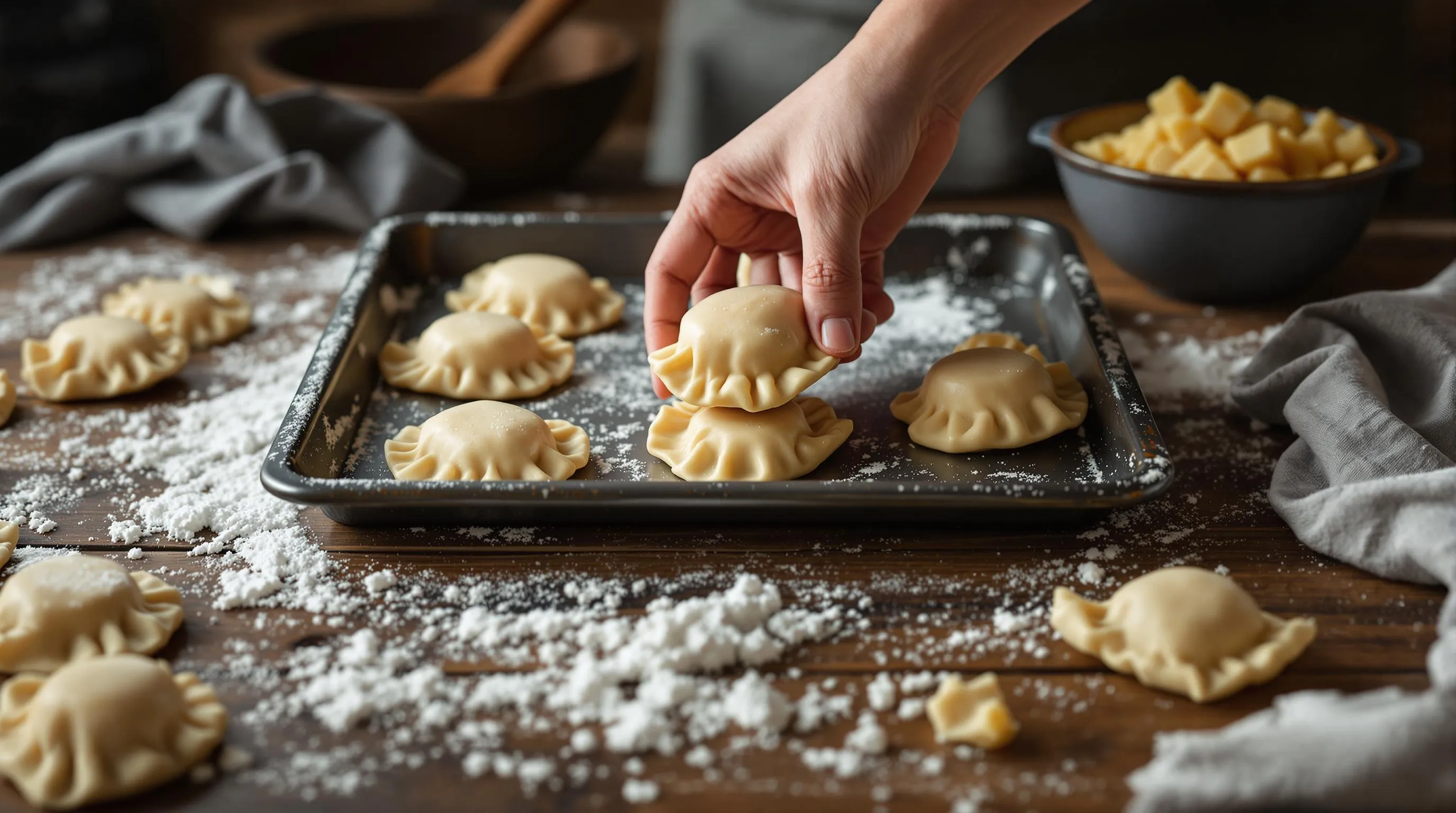
Properly storing homemade pierogies ensures you can enjoy these delicious Polish dumplings whenever cravings strike. Cooked pierogies stay fresh in an airtight container in the refrigerator for up to 3 days. Allow them to cool completely before transferring to storage containers separating layers with parchment paper to prevent sticking.
Freezing uncooked pierogies works exceptionally well making them perfect for meal prep. Place assembled raw pierogies on a flour-dusted baking sheet ensuring they don’t touch each other. Freeze until solid about 2 hours then transfer to freezer bags or containers. Label with the date and filling type for easy identification. Your frozen pierogies will maintain quality for up to 3 months.
For cooked pierogies you wish to freeze first allow them to cool completely. Arrange in a single layer on a baking sheet and freeze until firm. Transfer to freezer-safe containers with parchment paper between layers. These will keep well for up to 2 months.
Thawing isn’t necessary when cooking frozen pierogies. Add them directly to boiling water from frozen increasing the cooking time by about 3-4 minutes. Watch for them to float to the surface as an indicator of doneness. Pan-frying frozen pierogies works best when you boil them first then transfer to a hot skillet with butter or oil.
Batch cooking pierogies during weekend meal prep sessions provides quick dinner options throughout busy weekdays. Many Polish families traditionally gather for “pierogi parties” where they make hundreds at once freezing portions for future family meals and celebrations.
Remember that pierogies with dairy-based fillings like cheese might experience slight texture changes after freezing but the flavor remains delicious. Potato fillings freeze exceptionally well while fruit fillings may release additional moisture when thawed requiring a bit more cornstarch in the filling if you plan to freeze them.
Traditional Pierogi Variations
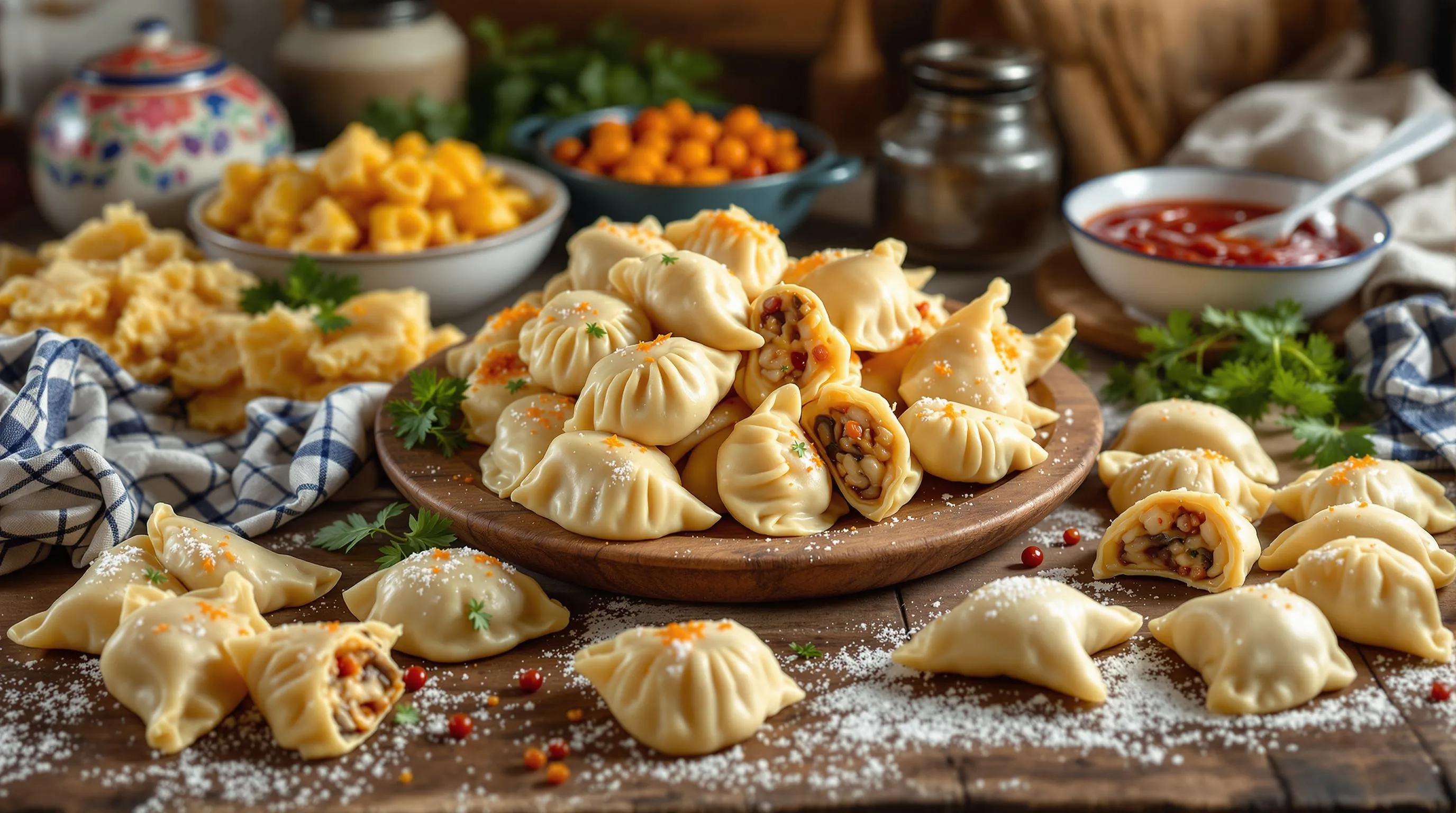
While potato and cheese filling remains the most iconic pierogi variety across Eastern Europe many regional and family variations have developed over centuries. Exploring these traditional options allows you to experience the full breadth of pierogi culture and find your personal favorite.
Savory Regional Classics
Ruskie (Russian-style) pierogies combine potato with farmer’s cheese and fried onions for a hearty filling beloved throughout Poland. Sauerkraut and mushroom pierogies represent another time-honored combination especially popular during Christmas Eve celebrations when meat is traditionally avoided. Meat fillings typically feature ground pork seasoned with marjoram garlic and sautéed onions creating a rich savory option for special gatherings.
Lithuanian-style pierogies often incorporate bacon bits directly into potato filling adding smoky depth. Ukrainian varenyky frequently feature cabbage onions and sometimes buckwheat for a distinctive earthy flavor profile. In parts of Slovakia pierogies might contain bryndza a unique sheep milk cheese that delivers tangy complexity to the humble dumpling.
Sweet Variations
Fruit-filled pierogies transform these versatile dumplings into delightful desserts or summer treats. Seasonal berries like blueberries strawberries or cherries create naturally sweet fillings that burst with flavor when cooked. Apple and cinnamon pierogies offer comforting warmth during colder months while plum pierogies with a hint of clove represent a traditional autumn variation.
Sweet cheese pierogies combine farmer’s cheese with sugar vanilla and sometimes raisins for a creamy dessert option often topped with melted butter and sprinkled with powdered sugar. Some regions feature sweet pierogies filled with poppy seed mixtures especially during holiday celebrations where they symbolize prosperity and abundance.
Regional Dough Variations
Traditional pierogi dough recipes vary significantly across Eastern Europe. Some regions incorporate whole eggs while others use only yolks for richer texture. Polish grandmother recipes often include sour cream in the dough creating tender results that stand up well to heartier fillings. Ukrainian variations might use kefir instead delivering a subtle tanginess to complement sweeter fillings.
Lithuanian cepelinai feature potato-based dough rather than wheat flour making them distinctly different from standard pierogies yet part of the same dumpling tradition. Russian pelmeni dough typically contains more eggs and less water resulting in a slightly firmer texture designed to withstand longer cooking times for meat fillings.
Unique Toppings and Serving Styles
Different regions pair their pierogies with distinctive toppings that complement exact fillings. Caramelized onions remain the most universal garnish adding sweet depth to almost any savory variation. Eastern Polish traditions might include pork cracklings (skwarki) for added richness while southern regions prefer browned butter with breadcrumbs.
Sweet pierogies often receive different treatment depending on local customs. Some regions serve them with sweetened sour cream while others prefer honey or fruit syrups. Ukrainian traditions sometimes include cherry sauce for cheese-filled varieties creating an interesting sweet-tangy contrast.
Soup-style pierogies appear in some regional cuisines where smaller dumplings are served directly in clear broth rather than as a separate dish. This preparation method highlights the dough’s texture while allowing simple fillings to shine without competing toppings.
The Perfect Toppings For Pierogies
While perfectly cooked pierogies are delicious on their own the right toppings can elevate these Polish dumplings to extraordinary heights. Traditional pierogi toppings enhance both texture and flavor creating a balanced dish that honors centuries of Eastern European culinary tradition.
Caramelized onions reign supreme as the classic pierogi topping. Slice yellow onions thinly and cook them slowly in butter over medium-low heat for 15-20 minutes until they turn golden brown and develop a sweet mellow flavor. This traditional topping adds a wonderful contrast to savory fillings especially potato and cheese varieties.
Sour cream serves as an essential accompaniment to almost all savory pierogies. A dollop of cold tangy sour cream balances the richness of the dumplings and creates a luxurious mouthfeel. For a lighter alternative try Greek yogurt which offers similar tanginess with added protein.
Crispy bacon bits provide a smoky salty element that pairs beautifully with the soft texture of pierogies. Cook bacon until crisp crumble it into small pieces and sprinkle generously over your dumplings for an indulgent treat. The rendered bacon fat can also replace butter when pan-frying pierogies adding incredible flavor.
Butter forms the foundation of many pierogi presentations. Simply melt a few tablespoons of high-quality butter and drizzle it over freshly boiled pierogies for a simple yet satisfying finish. Brown butter with a nutty aroma takes this approach to new heights – cook butter until it develops golden specks and a toasted fragrance.
Herbs add freshness and visual appeal to pierogi dishes. Chopped dill chives or parsley sprinkled just before serving brighten the flavors and cut through the richness. These green accents work particularly well with sauerkraut and potato fillings.
For sweet pierogies different toppings apply. Dust fruit-filled varieties with powdered sugar or cinnamon for a dessert-like presentation. Drizzle honey or maple syrup over sweet cheese pierogies or top with toasted nuts for added texture. Berry compotes provide a tart fruity complement that balances the sweetness.
Creative modern toppings have expanded the pierogi possibilities. Try these innovative options:
- Sautéed mushrooms with thyme
- Garlic-infused olive oil
- Balsamic reduction
- Sriracha sour cream
- Crumbled feta cheese
- Apple sauce (particularly with sweet pierogies)
- Pesto sauce
- Truffle oil (just a few drops)
Seasonal vegetables make excellent pierogi toppings throughout the year. In spring try asparagus tips or peas. Summer calls for sweet corn or zucchini. Fall brings roasted squash or brussels sprouts while winter offers braised red cabbage or caramelized root vegetables.
Regional Polish variations showcase unique topping combinations. In some areas skwarki (pork cracklings) provide a crunchy indulgent finish. Other regions feature pierogies topped with a mushroom or dill sauce called machanka. These regional specialties demonstrate how pierogi toppings vary across Poland’s diverse culinary industry.
Remember that toppings should complement rather than overwhelm your pierogies. The dumplings themselves remain the star while toppings enhance their natural flavors. Mix and match different options to create your own signature pierogi presentation that balances textures and tastes.
Conclusion
These homemade pierogies aren’t just a recipe – they’re a doorway to tradition that you can create right in your kitchen. With tender dough embracing flavorful fillings your family will treasure these handcrafted dumplings far more than any store-bought version.
Whether you’ve chosen classic potato and cheese savory sauerkraut or sweet fruit fillings your efforts will result in something truly special. The beauty of pierogies lies in their versatility – freeze extras for quick meals later or gather loved ones for a pierogi-making party.
Don’t worry if your first batch isn’t perfect. Like any cherished skill pierogi-making improves with practice. Soon you’ll develop your own signature variations that might just become your family’s new tradition for generations to come.

